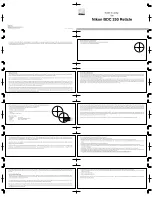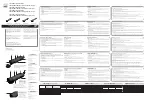
11
Depending on the altitude of the object you want to observe,
the counterweight shaft will be oriented somewhere between
vertical and horizontal.
Figure 10 illustrates how the telescope will look when pointed
at the four cardinal directions: north, south, east and west.
The key things to remember when pointing the telescope are
that a) you only move it in R.A. and Dec., not in azimuth or
latitude (altitude), and b) the counterweight and shaft will not
always appear as it does in Figure 1. In fact it almost never
will!
5. astronomical observing
site selection
Pick a location away from streetlights and bright yard lighting.
Avoid viewing over rooftops and chimneys, as they often have
warm air currents rising from them, which distort the image
seen in the eyepiece. Similarly, you should not observe through
an open window from indoors. Better yet, choose a site out-of-
town, away from any “light pollution”. You’ll be stunned at how
many more stars you’ll see! Most importantly, make sure that
any chosen site has a clear view of a large portion of the sky.
cooling Your telescope
As a general rule, telescopes should be allowed to “cool down”
(or warm up) before they are used. If you bring optics from a
warm air to cold air (or vice versa) without giving it time to
reach “thermal equilibrium”, your telescope will give you dis-
torted views. Allow your telescope 30 minutes to reach the
temperature of the outdoors before using.
seeing and transparency
Atmospheric conditions play a huge part in quality of viewing.
In conditions of good “seeing”, star twinkling is minimal and
objects appear steady in the eyepiece. Seeing is best over-
head, worst at the horizon. Also, seeing generally gets better
after midnight, when much of the heat absorbed by the Earth
during the day has radiated off into space. Typically, seeing
conditions will be better at sites that have an altitude over about
3000 feet. Altitude helps because it decreases the amount of
distortion causing atmosphere you are looking through.
A good way to judge if the seeing is good or not is to look at
bright stars about 40° above the horizon. If the stars appear to
“twinkle”, the atmosphere is significantly distorting the incom-
ing light, and views at high magnifications will not appear
sharp. If the stars appear steady and do not twinkle, seeing
conditions are probably good and higher magnifications will
be possible. Also, seeing conditions are typically poor during
the day. This is because the heat from the Sun warms the air
and causes turbulence.
Good “transparency” is especially important for observing faint
objects. It simply means the air is free of moisture, smoke, and
dust. All tend to scatter light, which reduces an object’s bright-
ness.
One good way to tell if conditions are good is by how many
stars you can see with your naked eye. If you cannot see
stars of magnitude 3.5 or dimmer then conditions are poor.
Magnitude is a measure of how bright a star is, the brighter a
star is, the lower its magnitude will be. A good star to remem-
ber for this is Megrez (mag. 3.4), which is the star in the “Big
Dipper” connecting the handle to the “dipper”. If you cannot
see Megrez, then you have fog, haze, clouds, smog, light pol-
lution or other conditions that are hindering your viewing. (See
Figure 11)
let Your Eyes Dark‑adapt
Do not expect to go from a lighted house into the darkness
of the outdoors at night and immediately see faint nebulas,
galaxies, and star clusters - or even very many stars, for that
matter. Your eyes take about 30 minutes to reach perhaps
80% of their full dark-adapted sensitivity. Many observers
notice improvements after several hours of total darkness. As
your eyes become dark-adapted, more stars will glimmer into
view and you will be able to see fainter details in objects you
view in your telescope. So give yourself at least a little while to
get used to the dark before you begin observing.
To see what you are doing in the darkness, use a red light
flashlight rather than a white light. Red light does not spoil
your eyes’ dark adaptation like white light does. A flashlight
with a red LED light is ideal, or you can cover the front of a
regular flashlight with red cellophane or paper. Beware, too,
that nearby porch and streetlights and automobile headlights
will spoil your night vision.
Figure 10
This illustration shows the telescope pointed in the four cardinal directions (a) North, (b) South, (c) East, (d) West. Note that the
tripod and mount have not been moved; only the telescope tube has moved on the R.A. and Dec. axes
a.
b.
c.
d.






























